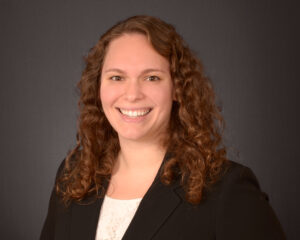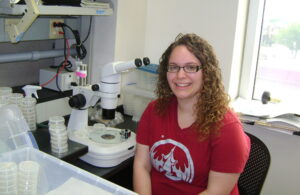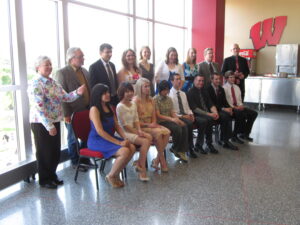From baby powder to food flavorings, alumna Heidi Reamer’s work keeps consumers and workers safe
By Katie Ginder-Vogel
In lawsuits alleging that chemical substances have caused harm, experts weigh in, citing literature and experiments, to determine what chemicals and at what concentrations might pose a risk. Heidi Reamer (BS ’12) helps equip those experts with the information they need to take the stand or provide evidence for a trial.
As a health scientist at Cardno ChemRisk, Reamer’s role is divided between preparation for litigation and research, and she works with experts in various health-related sciences to develop risk assessments, in support of trials as well as non-litigation contaminated site, product and food safety, and applied toxicology projects.
“We do research to fill knowledge gaps and communicate our findings in conference presentations and peer-reviewed articles,” says Reamer, a graduate of the University of Wisconsin–Madison School of Pharmacy’s Pharmacology and Toxicology program. “The most important thing we do is risk assessments for clients — we characterize risk and communicate it to them so they can make an informed decision about how to minimize it. That directly impacts human health in positive ways.”
Preserving health and safety
For companies in various sectors related to human health, Cardno ChemRisk provides expert opinions on exposure, risk of disease, and occupational hazards for use in trials and non-litigation projects. The company’s service areas include contaminated sites, product and food safety, and applied toxicology. Reamer’s focus areas are asbestos, pesticides/herbicides, PFAS, and talc.
“It’s an exciting career path because you don’t know what might come through the door each day.”
—Heidi Reamer
“My role in litigation and science in the courtroom is to manage the project and make sure we have the information we need about the science and each case. I help the experts pull and review literature, help them develop their opinions on the chemical in relation to the case, answer questions, and collaborate with them, and inform very technical risk assessment reports,” says Reamer. “We can talk in depth about science at work, but in the courtroom, you must explain these complex topics to the jury in a way that they can understand and assess during decision-making.”
One of Reamer’s major projects at the company involves talc litigation. Cardno ChemRisk conducts risk assessments relating to alleged exposures associated with makeup, body powder, and baby powder.

“We also provide state-of-the-science opinions regarding talc, which include a description of what was known within the scientific community about the composition of a product and the hazards associated with that product over time,” says Reamer. “A lot of what we do involves reviewing a vast number of documents and information, analyzing it, and presenting it in a way that clearly communicates our conclusions on that material.”
Another one of Reamer’s litigation projects was related to flavoring chemicals used in snack food manufacturing.
“There were allegations that these chemicals were causing lung injury in manufacturing workers,” says Reamer.
In that case, they gathered scientific evidence and determined that the flavoring chemicals were not expected to increase the risk of lung injury. Reamer’s team conducted a risk assessment on the flavoring chemicals, which involved an assessment of the toxicology and exposure literature, as well as a state-of-the-science review.
“I was also able to conduct site visits to a few manufacturing sites that made the snack products,” adds Reamer. “It was a valuable experience to be at a facility that I had read so much about.”
Collaborating on research
Reamer has a toxicology background, and she frequently works alongside experts in other areas to ensure their research is well-rounded.
“I work with industrial hygienists, who focus on worker health and safety; epidemiologists, who look at health on a population level; environmental toxicologists; physicians; and biostatisticians,” she says. The collaborative environment has allowed her to get involved with projects outside of her wheelhouse and continue building her knowledge base in toxicology.
“I work with some PhD toxicologists who have been in the field for over 30 years, so that has pushed me to advance my skill set in toxicology,” says Reamer.
While earning her bachelor’s degree from the School’s PharmTox program, she also completed research at the Chicago Stritch School of Medicine as an American Society for Pharmacology and Experimental Therapeutics Discover Pharmacology Research Fellow in 2011. Now, in addition to working full-time, Reamer is earning her master’s degree in public health at Northeastern Illinois University in Chicago and plans to graduate in 2022.

“In consulting, you can grow and learn from your coworkers, and we publish a lot, so there’s lots of opportunity for training and professional development,” says Reamer. “Because I have a smattering of this informal training, I was interested in making that more formal by earning my master’s degree.”
Reamer also gets dedicated time to pursue her own research interests, with the expectation that she will publish and present her findings.
She and several colleagues recently published an exposure assessment of formaldehyde in laminate flooring. Responding to a news story that dangerous levels of formaldehyde were emitted from flooring, Reamer and her colleagues decided to conduct their own real-world assessment.
“We installed a small amount of laminate flooring, and sampled for formaldehyde concentrations over time,” Reamer explains. “For the flooring we tested, the formaldehyde levels we measured would not have been expected to cause any negative health effects.” Reamer presented their findings at a national industrial hygiene conference.
Most recently, Reamer and her colleagues evaluated glyphosate exposure from the application of a popular herbicide. Urinary concentrations of glyphosate were measured after the application of the herbicide and, based on the results, they completed and published a comprehensive risk assessment of glyphosate exposure using a margin of safety approach.
“My training at UW–Madison directly translated to the work I did on this project,” says Reamer. “I needed my knowledge of toxicology to understand the toxicokinetics of glyphosate, to calculate the internal dose, and to understand health-based guidance values.”
Overall, the team found that the doses experienced by the herbicide applicators in this study were below the health-based guidance values.
Finding her footing in PharmTox
As a freshman at UW–Madison, Reamer envisioned herself as a future geneticist, until she received an email about the Pharmacology and Toxicology program at the School of Pharmacy. The description caught her eye: small lab classes alongside graduate and PharmD students.
As a genetics major, she had all the prerequisites completed to switch to the PharmTox program, where she was able to continue her research in the lab of Scott Kennedy in the UW Department of Genetics.
“Being able to work alongside graduate students was amazing,” Reamer says. “I didn’t end up at the bench, but having experience in the lab and reading published literature transferred to my job, where I need to read literature, look at it critically, and understand the topic.”

One of Reamer’s favorite courses was a graduate-level biochemistry class on signaling and transduction, in which the students read exclusively peer-reviewed literature. She says she was impacted by the graduate students’ way of studying for a deep understanding.
The PharmTox program is known for its challenging coursework, and Reamer found a close group of friends among her small cohort of 14.
“We’d end up at the medical school library, park ourselves on Friday night, and stay until they made us leave,” she laughs. “In a small cohort of people, finding my friends to help me through everything was key.”
It was the PharmTox program that also connected her with her future employer. In her senior year, Reamer was exploring jobs in the pharmaceutical industry when a Cardno ChemRisk employee came to the School to speak to students — and she was fascinated. After the presentation, the Cardno ChemRisk representative did interviews on campus with interested students, including Reamer. Impressed by Reamer, the representative referred her for a formal interview in Chicago, and Reamer landed the job.
“I was really interested in the idea of taking my education and applying it to a large range of problems and different chemicals for risk assessment,” Reamer says. “It’s an exciting career path because you don’t know what might come through the door each day.”